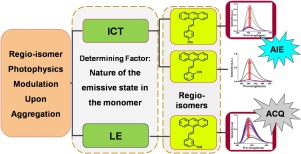Journal of Photochemistry and Photobiology A: Chemistry ( IF 4.1 ) Pub Date : 2020-03-05 , DOI: 10.1016/j.jphotochem.2020.112458 Swatilekha Pratihar , Ayan Bhattacharyya , Edamana Prasad

|
Design and synthesis of molecular assemblies which exhibit aggregation-induced emission (AIE) have attracted persistent attention in recent years. However, studies on the impact of the substitution position in isostructural molecules to regulate aggregation-induced emission (AIE) or convert aggregation-caused quenching (ACQ) to AIE have not been reported to date. In the present study, aggregation properties of two isostructural fluorophores viz. (E)-4-(2-(anthracen-9-yl)vinyl)benzonitrile (p-AnCN) and (E)-3-(2-(anthracen-9-yl)vinyl)benzonitrile (m-AnCN), with different substitution positions have been evaluated. It was observed that m-AnCN exhibits an ACQ behavior, whereas, p-AnCN exhibits enhanced emission upon aggregation. Upon aggregation, c.a. 1.4-fold decrease in luminescence quantum yield has been observed for m-AnCN, whereas, c.a. 11-fold enhancement in luminescence quantum yield has been achieved for p-AnCN. Results from the study indicate that absence of interplay between the excited states from a dark Intramolecular Charge Transfer (ICT) state to Locally Excited state (LE) in m-AnCN is the primary reason behind the observed difference in the emission properties of the aggregates. Thus, modulation of ACQ-AIE properties has been achieved using isostructural organic fluorophores, which in turn can be used as a versatile strategy to achieve AIE-luminophores. Further, the AIE active p-AnCN aggregates have been utilized to generate three-component white light emission with CIE coordinates of (0.33, 0.33).
中文翻译:

使用同构有机荧光团实现ACQ-AIE调制
表现出聚集诱导发射(AIE)的分子组件的设计和合成近年来引起了持续的关注。但是,迄今为止,尚未有关于同结构分子中的取代位置对调节聚集诱导发射(AIE)或将聚集引起的猝灭(ACQ)转换为AIE影响的研究。在本研究中,两个同构荧光聚集性质即。(E)-4-(2-(蒽-9-乙烯基)乙烯基)苄腈(p -AnCN)和(E)-3-(2-(蒽-9-乙烯基)乙烯基)苄腈(m -AnCN),评估了具有不同取代位置的化合物。观察到,m- AnCN表现出ACQ行为,而p-AnCN在聚集时表现出增强的发射。聚集后,对于m -AnCN观察到发光量子产率降低约1.4倍,而对于p -AnCN观察到发光量子产率提高约11倍。研究结果表明,在m- AnCN中,从暗分子内电荷转移(ICT)态到局部激发态(LE)的激发态之间没有相互作用,这是观察到聚集体发射特性差异的主要原因。因此,已经使用同结构有机荧光团实现了对ACQ-AIE性质的调节,而该荧光团又可以用作实现AIE发光团的通用策略。此外,AIE主动p-AnCN聚集体已用于生成三组分白光发射,CIE坐标为(0.33,0.33)。











































 京公网安备 11010802027423号
京公网安备 11010802027423号